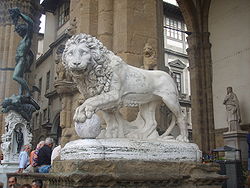Flaminio Vacca
Contenu soumis à la licence CC-BY-SA. Source : Article Flaminio Vacca de Wikipédia en français (auteurs)
Regardez d'autres dictionnaires:
Flaminio Vacca — or Vacchi (Caravaggio ot Rome, 1538 – Rome, 1605) was an Italian sculptor. His sculptural work can be seen in Rome in the grandiose funeral chapel of Pope Pius V designed by Domenico Fontana at the Basilica di Santa Maria Maggiore ( Saint Francis … Wikipedia
Flaminio Vacca — Vacca s Löwe aus der Villa Medici in Rom, heute Loggia dei Lanzi, Florenz Flaminio Vacca oder auch Vacchi (* 1538 in oder bei Rom; † 1605 in Rom) war ein italienischer Bildhauer des Manierismus. Inhaltsverz … Deutsch Wikipedia
Vacca — ist der Familienname folgender Personen: Antonio Vacca (* 1934), Altbischof von Alghero Bosa Flaminio Vacca (1538 1605), italienischer Bildhauer Giovanni Enrico Eugenio Vacca (1872–1953), italienischer Mathematiker Vacca steht außerdem für: Vaga … Deutsch Wikipedia
Menelaus supporting the body of Patroclus — Menelaus supporting the body of Patroclus, in the Loggia dei Lanzi, Florence The marble sculpture usually given the rather arbitrary title Menelaus supporting the body of Patroclus (also known as Pasquino Group) due to its apparent representation … Wikipedia
Loggia Dei Lanzi — La loggia depuis la place de la Seigneurie. Au fond, les Offices … Wikipédia en Français
Loggia dei Lanzi — 43° 46′ 09″ N 11° 15′ 21″ E / 43.7692, 11.2557 … Wikipédia en Français
Loggia dei lanzi — La loggia depuis la place de la Seigneurie. Au fond, les Offices … Wikipédia en Français
Medici-Löwen — Treppen zum Garten der Villa Medici in Rom Als Medici Löwen werden die beiden Löwen Skulpturen bezeichnet, die um 1598 am Treppenaufgang der Gartenseite der Villa Medici in Rom aufgestellt und 1789 in die Loggia dei Lanzi in Florenz versetzt… … Deutsch Wikipedia
Medici lions — This article is about the sculptures of lions with spheres. For the heraldic symbol of Florence, see Marzocco. Vacca s lion … Wikipedia
Pantheon, Rome — The Pantheon (Latin Pantheon , [Rarely Pantheum . This rare usage appears in Pliny s Natural History (XXXVI.38) in describing this edifice: Agrippae Pantheum decoravit Diogenes Atheniensis; in columnis templi eius Caryatides probantur inter pauca … Wikipedia


